Chronicon Pictum
The Chronicon Pictum or Illuminated Chronicle (Latin for "Illustrated Chronicle", Hungarian: Képes Krónika, Slovak: Obrázková kronika, German: Ungarische Bilderchronik, also referred to as Chronica Hungarorum, Chronicon Hungarie Pictum, Chronica Picta or Chronica de Gestis Hungarorum) is a medieval illustrated chronicle from the Kingdom of Hungary from the 14th century. It represents the great international artistic style of the royal courts in the court of King Louis I of Hungary. The codex is a unique source of art, medieval and cultural history.
 The first page of the Chronicon Pictum. King Louis I on the throne, below the Hungarian Anjou and the Hungarian coat of arms. | |
| Author | Mark of Kalt |
|---|---|
| Country | Kingdom of Hungary |
| Language | Latin |
| Subjects | History of the Hungarians |
| Genre | Chronicle |
| Published | 1358 |
| Media type | Illuminated manuscript |
| Pages | 146 |
The chronicle's full name is: Chronicon Pictum – Marci de Kalt Chronica de Gestis Hungarorum (Illustrated Chronicle – Mark of Kalt's Chronicle About the Deeds of the Hungarians).
History of the chronicle
The chronicle was written by Mark of Kalt (Latin: Marci de Kalt, Hungarian: Kálti Márk) in 1358 in Latin, with the last of the illuminations being finished between 1370 and 1373.
According to historian Bálint Hóman, the original source of all extant Hungarian chronicles was the lost Gesta Ungarorum, which was written in the time of King Saint Ladislaus.[1] The basic premise of the Hungarian medieval chronicle tradition that the Huns, i.e. the Hungarians coming out twice from Scythia, the guiding principle was the Hun-Hungarian continuity.[2]
The chronicle was given by the great Hungarian king Louis I to the French king Charles V, when the daughter of Louis, Catherine, was engaged to Charles's son Louis I, Duke of Orléans in 1374.[3] The chronicle was then given to Serbian despot Đurađ Branković as gift from the French king Charles VII. The chronicle was copied in 1462. Between 1458 and 1490, it was still in Hungary, in the court of King Matthias,[4] and later lost, possibly spending some time in Turkish possession.[3] There is evidence to suggest that in the second half of the 15th century the chronicle was in Hungary, it also contains several handwritten Hungarian and Latin entries from the 15th and 16th centuries, even in three places with Turkish writing in Hungarian. From the fact that it contains Turkish comments related to Hungary, the researchers concluded that between the end of the 15th century and the beginning of the 17th century, the codex was owned by a Hungarian who knew Turkish very well. The chronicle may have fled Vienna from the Ottoman occupation in the 16th century. From the 17th century, it belonged to the court library in Vienna. Sebastian Tengnagel mentions it in the manuscript catalog of the court library from 1608 to 1636. The chronicle reappears in the first half of the 17th century in royal archives of Vienna by unknown means, which is why it is also referred as the Vienna Illuminated Chronicle. As a result of the Venice Cultural Convention, the chronicle returned to Hungary in 1934. The manuscript is now kept in the National Széchényi Library in Budapest, Hungary.[3]
Illuminations
The 147 pictures of the chronicle are an inexhaustible source of information on medieval Hungarian cultural history, costume and court life, they also represent the most important records extent of Hungarian painting in the 14th century. The artistic value of the miniatures is quite high, and the characters are drawn with detail and with a knowledge of anatomy.[5] The chronicle contains 147 miniatures: 10 larger images, 29 images in the width of the column, 4 smaller images at the bottom of the page in a round medallion shape, 99 images enclosed in initials, and 5 initials without images. In addition, there are 82 ornaments at the margin.
The images are listed in the same order as their appearance in the chronicle.
| Page | Illumination | Description |
|---|---|---|
| Page 1 | .jpg.webp) King Louis on the Throne |
King Louis on the Throne
Saint Catherine of Alexandria
|
| Page 2 | 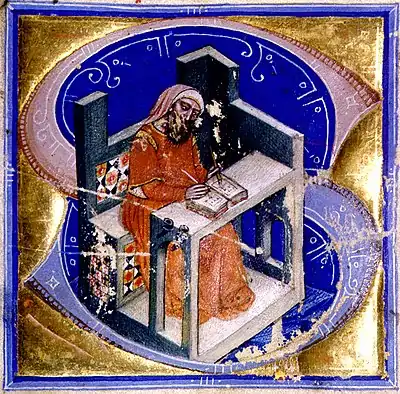 The Historiographer |
The Historiographer
|
| Page 5 | The Miraculous Deer |
The Miraculous Deer
|
| Page 7 |  The First Arrival of the Hungarians in Pannonia |
The First Arrival of the Hungarians in Pannonia
|
| Page 9 | 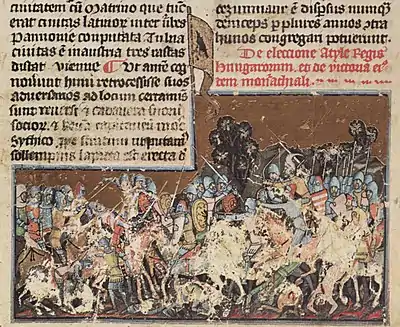 Attila’s Battle With the Romans at Zeiselmauer |
Attila’s Battle With the Romans at Zeiselmauer
|
| Page 10 |  King Attila on the Throne |
King Attila on the Throne
|
| Page 11 | 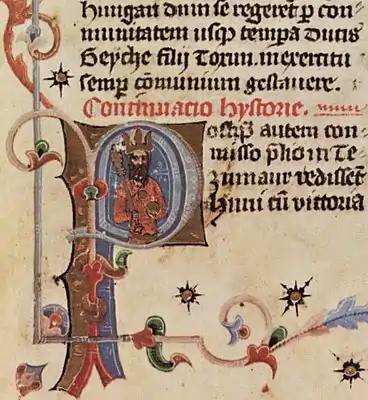 King Attila |
King Attila
|
| Page 13 | .jpg.webp) King Attila |
King Attila
|
| Page 14 | Attila is Besieging Aquileia |
Attila is Besieging Aquileia
|
| Page 14 |  King Attila with the Turul bird in his shield |
King Attila |
| Page 15 | 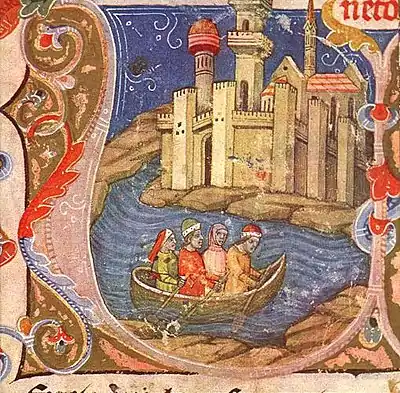 Foundation of Venice |
Foundation of Venice
|
| Page 16 | King Attila and Pope Leo |
King Attila and Pope Leo |
| Page 21 | The Arrival of the Hungarians in Pannonia |
The Arrival of the Hungarians in Pannonia
Előd, Hungarian Chieftain
Álmos, Hungarian Chieftain |
| Page 21 | The Arrival of the Hungarians in Pannonia |
The Arrival of the Hungarians in Pannonia
|
| Page 21 | 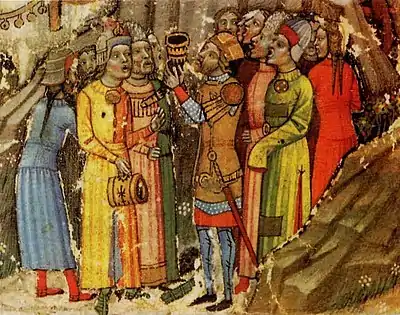 The Arrival of the Hungarians in Pannonia (Detail) |
The Arrival of the Hungarians in Pannonia (Detail)
|
| Page 21 | 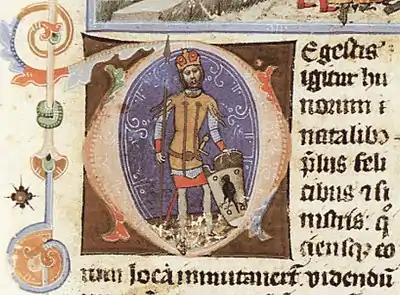 Előd, Hungarian Chieftain |
Előd, Hungarian Chieftain |
| Page 21 | 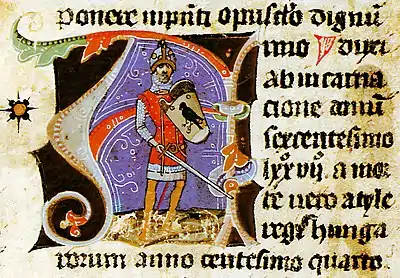 Álmos, Hungarian Chieftain |
Álmos, Hungarian Chieftain
|
| Page 23 | The Seven Captains |
The Seven Captains
|
| Page 23 | 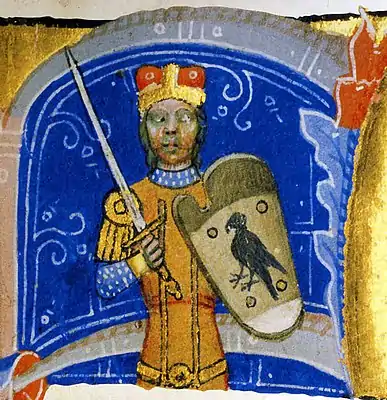 Árpád, the First Captain |
Árpád, the First Captain
|
| Page 25 | 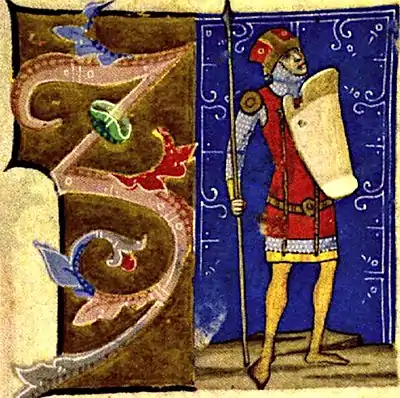 Szabolcs, the Second Captain |
Szabolcs, the Second Captain
|
| Page 25 | 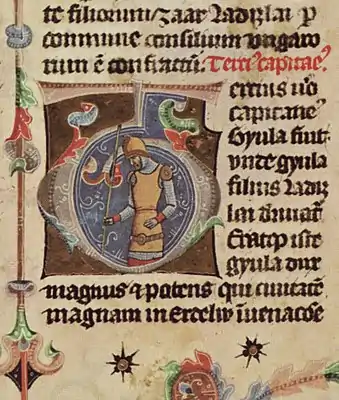 Gyula, the Third Captain |
Gyula, the Third Captain
|
| Page 26 |  Kund, the Fourth Captain |
Kund, the Fourth Captain
|
| Page 26 | 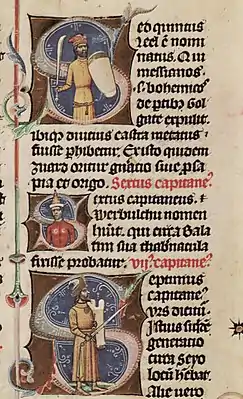 Chieftain Lehel, Bulcsú and Örs |
Lehel, the Fifth Captain
Bulcsú, the Sixth Captain
Örs, the Seventh Captain
|
| Page 28 | 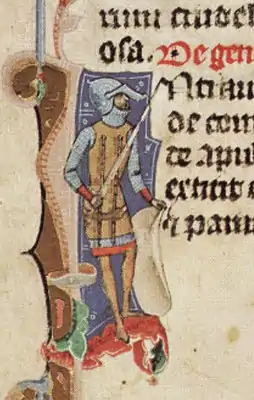 Count Deodatus |
Count Deodatus
|
| Page 28 | 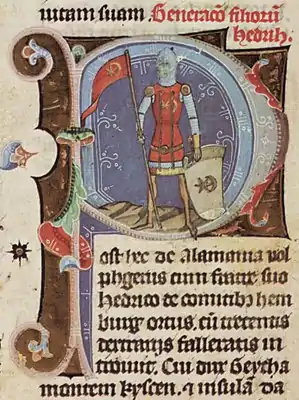 Héder |
Héder
|
| Page 29 | 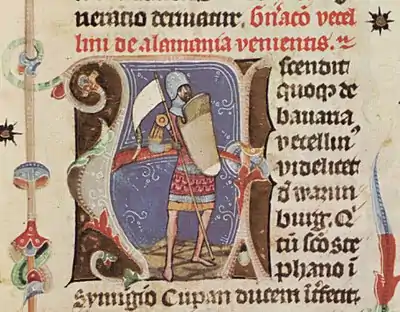 Vencellin |
Vencellin
|
| Page 29 |  Hont |
Hont
|
| Page 29 | 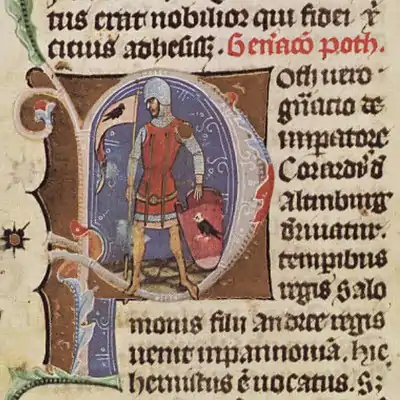 Poth |
Poth
|
| Page 30 |  Oliver and Rátold |
Oliver and Rátold
|
| Page 30 | 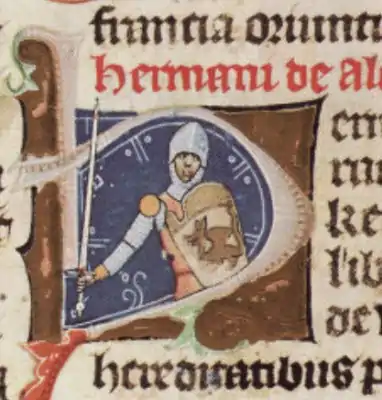 Herman |
Herman
|
| Page 30 | 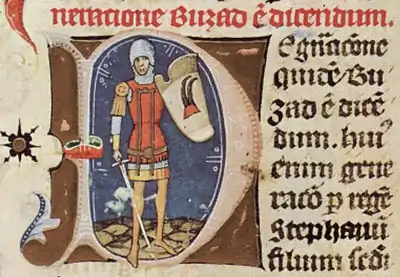 Buzád |
Buzád
|
| Page 31 | 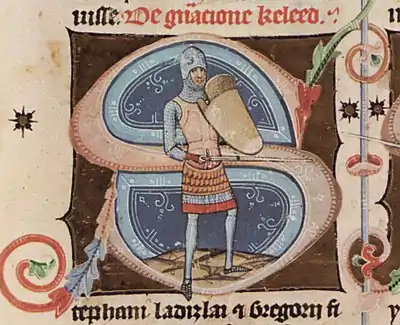 Keled |
Keled
|
| Page 31 | 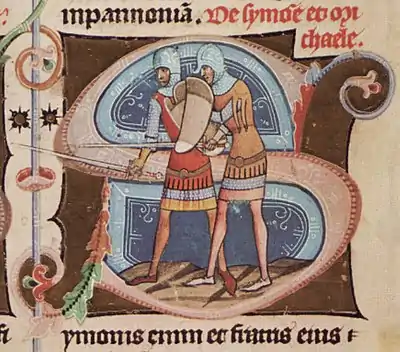 Simon and Michael |
Simon and Michael
|
| Page 32 | 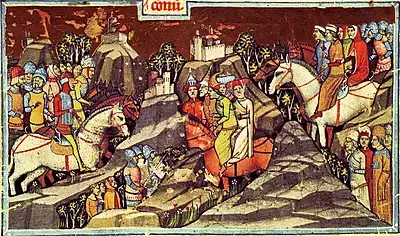 The Arrival of Different Clans to Hungary |
The Arrival of Different Clans to Hungary
|
| Page 32 | 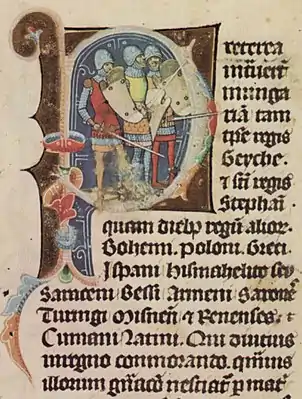 Three Knights |
Three Knights
|
| Page 33 | 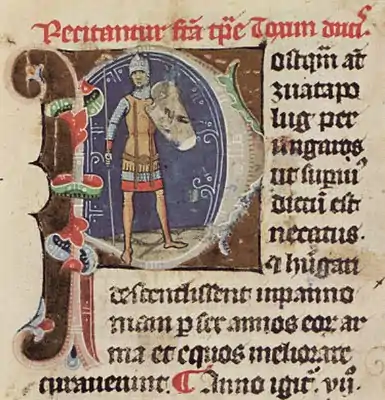 Grand Prince Taksony |
Grand Prince Taksony |
| Page 33 | 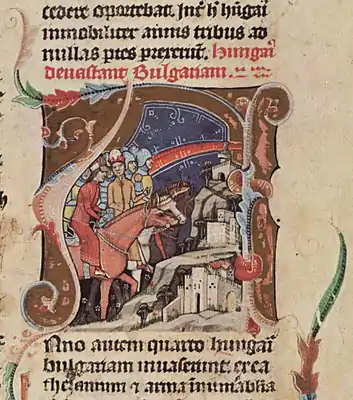 The Hungarians Are Destroying Bulgaria |
The Hungarians Are Destroying Bulgaria
|
| Page 34 | Captain Lehel and Bulcsu Front of the German Emperor |
Captain Lehel and Bulcsú Front of the German Emperor
|
| Page 36 | Duel of Botond and the Greek Warrior in Front of the Gates of Constantinople |
Duel of Botond and the Greek Warrior in Front of the Gates of Constantinople
|
| Page 36 |  Captain Apor |
Captain Apor |
| Page 37 |  Birth of King Stephen |
Birth of King Stephen
|
| Page 38 | Grand Prince Géza |
Grand Prince Géza
|
| Page 38 | 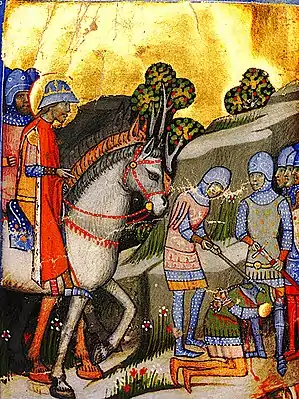 The Decapitation of Koppány |
The Decapitation of Koppány
|
| Page 39 | King Saint Stephen in military ornament |
King Saint Stephen in Military Ornament
|
| Page 40 | King Saint Stephen captures Gyula |
King Saint Stephen Captures Gyula
|
| Page 40 | 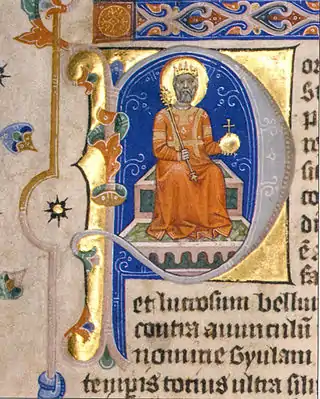 King Stephen on the Throne |
King Saint Stephen on the Throne
|
| Page 41 | The Victory of King Stephen over Kean, Duke of the Bulgarians and Slavs |
The Victory of King Stephen over Kean, Duke of the Bulgarians and Slavs
|
| Page 41 | 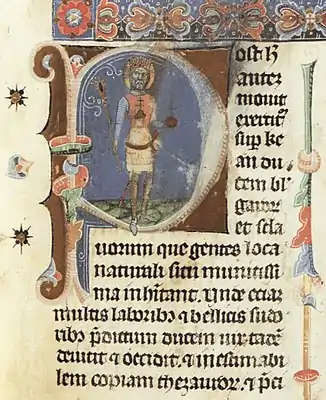 King Stephen in Royal Regalia |
King Stephen in Royal Regalia
|
| Page 42 | The Foundation of Saints Peter and Paul Church of Óbuda |
The Foundation of Saints Peter and Paul Church of Óbuda
|
| Page 44 | 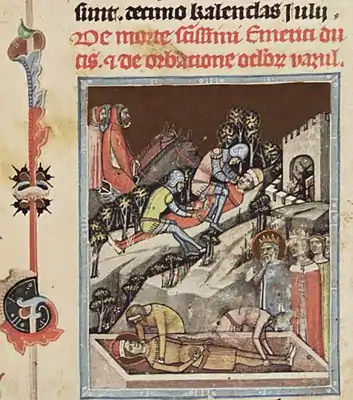 Prince Emeric’s Funeral and the Blinding of Vazul |
Prince Emeric’s Funeral and the Blinding of Vazul
|
| Page 44 | 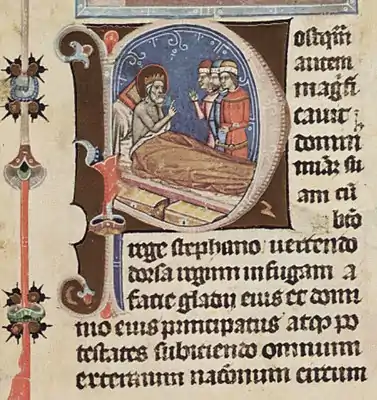 King Stephen Encourages Prince Andrew, Béla and Levente to Flee |
King Stephen Encourages Prince Andrew, Béla and Levente to Flee
|
| Page 46 | 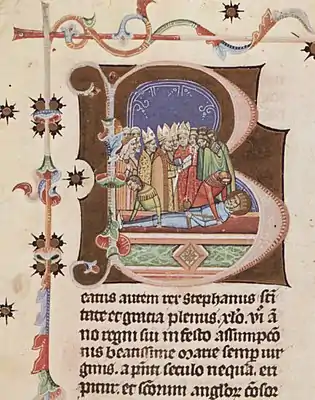 King Stephen's Funeral |
King Stephen's Funeral
|
| Page 47 |  King Peter |
King Peter
|
| Page 47 | 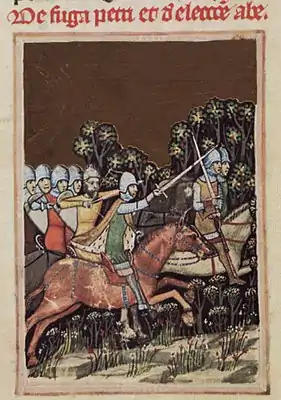 King Peter Is Driven Away by Samuel Aba and His Soldiers |
King Peter Is Driven Away by Samuel Aba and His Soldiers
|
| Page 48 | 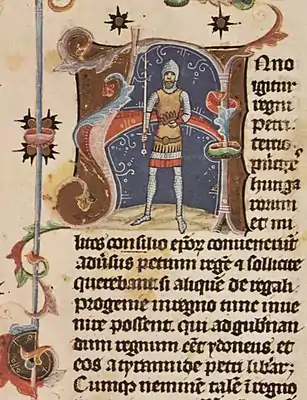 King Samuel Aba |
King Samuel Aba
|
| Page 50 | Battle of Ménfő: Victory of Emperor Henry III Over King Samuel Aba |
Battle of Ménfő: Victory of Emperor Henry III Over King Samuel Aba
|
| Page 50 | 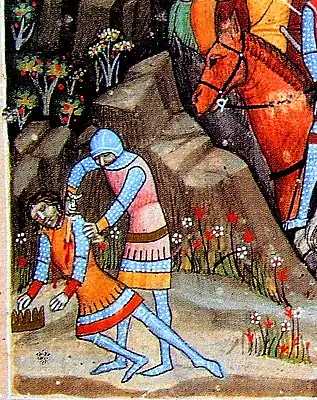 Battle of Ménfő: Killing of King Samuel Aba |
Battle of Ménfő: Victory of Emperor Henry III Over King Samuel Aba (Detail)
|
| Page 50 | 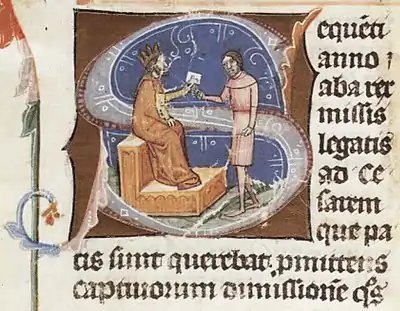 King Aba’s Envoy Delivers a Letter Written in Favor of Peace to the German Emperor |
King Aba’s Envoy Delivers a Letter Written in Favor of Peace to the German Emperor
|
| Page 53 | King Peter Gives Hungary as a Vassal to the German Emperor |
King Peter Gives Hungary as a Vassal to the German Emperor
|
| Page 54 | 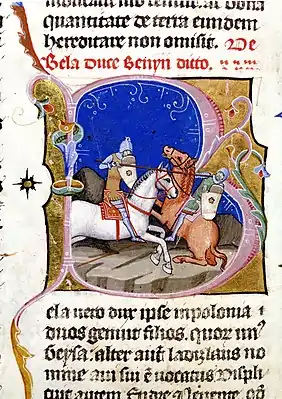 Prince BéLa’s Duel With the Pomeranian |
Prince Béla’s Duel With the Pomeranian
|
| Page 59 |  King Peter’s Blinding, Prince Andrew Takes the Crown |
King Peter’s Blinding, Prince Andrew Takes the Crown
|
| Page 60 | 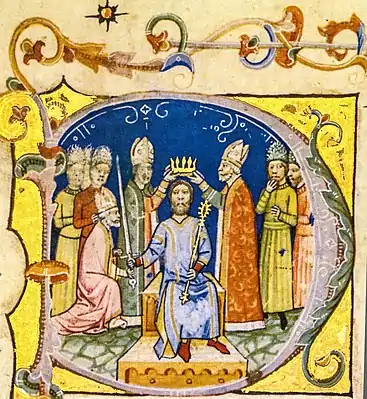 Coronation of King Andrew |
Coronation of King Andrew
|
| Page 61 | 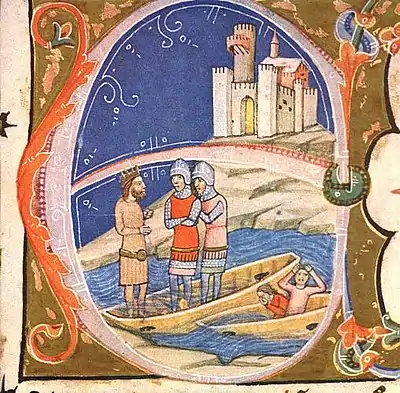 The Destruction of Emperor Henry’s Ships at Pozsony |
The Destruction of Emperor Henry’s Ships at Pozsony
|
| Page 64 |  The Scene of Várkony: The Crown and Sword |
The Scene of Várkony: The Crown and Sword
|
| Page 67 | 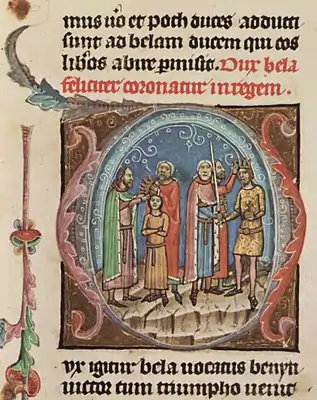 Prince Béla Wins the Crown |
Prince Béla Wins the Crown |
| Page 69 | German Emperor Henry IV Brings Solomon Back to Hungary |
German Emperor Henry IV Brings Solomon Back to Hungary
|
| Page 71 |  King Solomon and His Younger Brother Prince David |
King Solomon and His Younger Brother Prince David |
| Page 72 |  Prince Ladislaus Is Fighting a Duel With a Cuman Warrior Who Kidnapped a Girl |
Prince Ladislaus Is Fighting a Duel With a Cuman Warrior Who Kidnapped a Girl
|
| Page 72 | .jpg.webp) Prince Ladislaus Is Fighting a Duel With a Cuman Warrior Who Kidnapped a Girl |
Prince Ladislaus Is Fighting a Duel With a Cuman Warrior Who Kidnapped a Girl
|
| Page 74 | .jpg.webp) The Capture of Belgrade and the Distribution of the Spoils of War |
The Capture of Belgrade and the Distribution of the Spoils of War
|
| Page 78 | The Feud Between King Solomon and Prince Géza |
The Feud Between King Solomon and Prince Géza
|
| Page 78 | The People of Niš Pay Homage to King Solomon and Prince Géza |
The People of Niš Pay Homage to King Solomon and Prince Géza
|
| Page 81 | 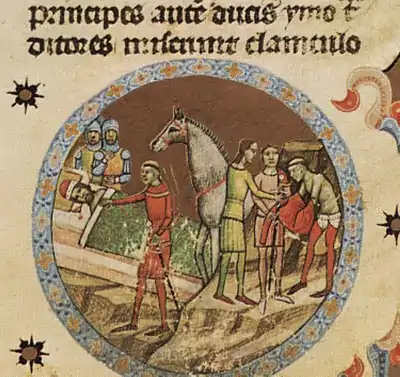 Prince Géza and Abbot Villermus |
Prince Géza and Abbot Villermus
|
| Page 81 | 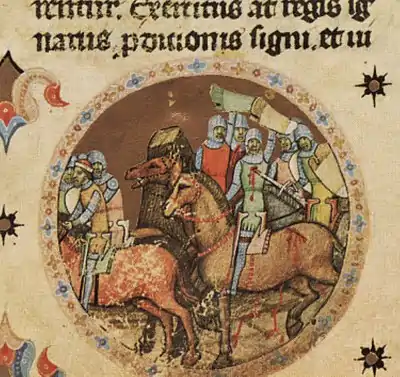 Escape of Prince Géza |
Escape of Prince Géza |
| Page 83 | 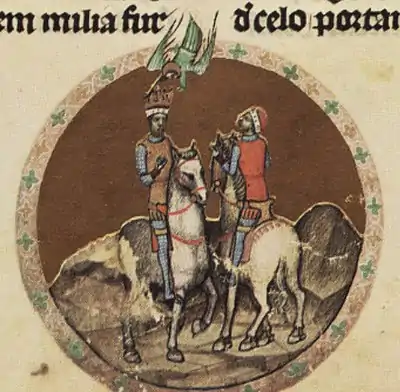 The Vision of Prince Ladislaus |
The Vision of Prince Ladislaus
|
| Page 85 | The Battle of Mogyoród |
The Battle of Mogyoród |
| Page 87 |  The Vision of King Géza and Prince Ladislaus |
The Vision of King Géza and Prince Ladislaus
|
| Page 89 | 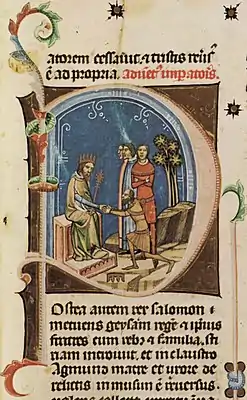 King Solomon Again Asks for Help From the German Emperor |
King Solomon Again Asks for Help From the German Emperor |
| Page 91 | 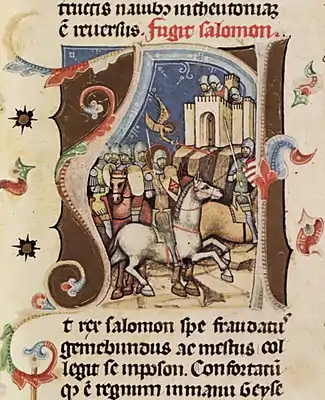 The Escape of King Solomon |
The Escape of King Solomon
|
| Page 92 | The Coronation of Ladislaus the First |
The Coronation of Ladislaus the First
|
| Page 93 | King Saint Ladislaus, the Knight King |
King Saint Ladislaus, the Knight King
|
| Page 98 |  The Ruthenians Pledge Allegiance to King Ladislaus |
The Ruthenians Pledge Allegiance to King Ladislaus
|
| Page 98 | 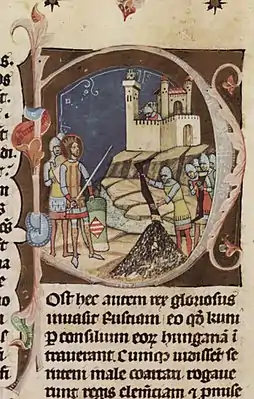 Siege of Kraków |
Siege of Kraków
|
| Page 99 | 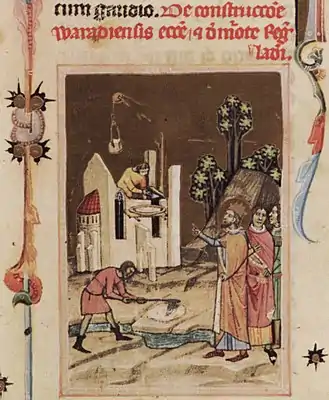 Construction of the Nagyvárad's Church |
Construction of the Nagyvárad's Church
|
| Page 99 |  King Ladislaus Receives Ambassadors |
King Ladislaus Receives Ambassadors
|
| Page 101 |  Funeral of King Saint Ladislaus |
Funeral of King Saint Ladislaus
|
| Page 101 | 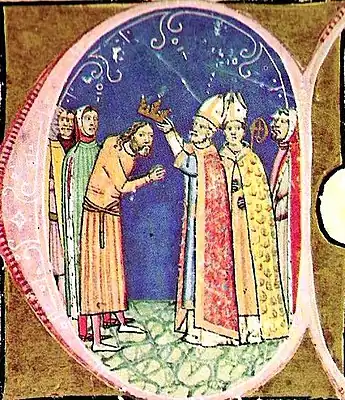 The Coronation of Coloman |
The Coronation of Coloman |
| Page 105 | King Coloman and Prince Álmos in Front of the Church of Dömös |
King Coloman and Prince Álmos in Front of the Church of Dömös |
| Page 105 | 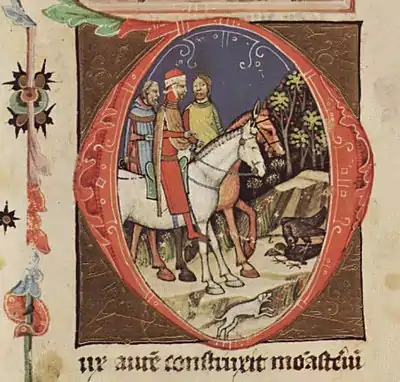 The Hunt in Csór |
The Hunt in Csór
|
| Page 106 |  The Blinding of Prince Álmos and His Little Son Béla |
The Blinding of Prince Álmos and His Little Son Béla
|
| Page 106 | King Coloman Wants to Capture Prince Álmos |
King Coloman Wants to Capture Prince Álmos
|
| Page 108 | 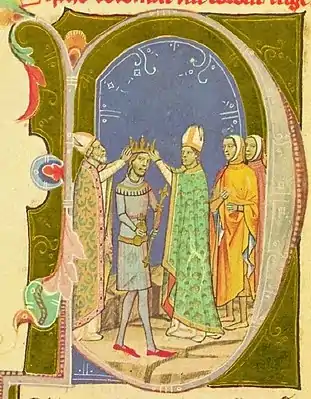 The Coronation of Stephen II, Coloman's Son |
The Coronation of Stephen II, Coloman's Son |
| Page 113 | The Assembly of the Realm of Arad |
The Assembly of the Realm of Arad
|
| Page 114 | _B%C3%A9la_uralkod%C3%B3i_d%C3%ADszben.jpg.webp) King Béla II |
King Béla II
|
| Page 117 | 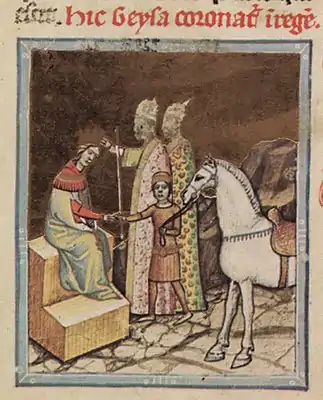 Coronation of King Géza II |
Coronation of King Géza II |
| Page 117 | 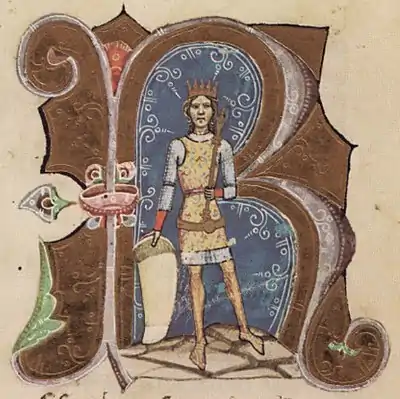 King Géza II in Royal Regalia |
King Géza II in Royal Regalia
|
| Page 119 |  German Emperor Konrad III and French King Louis VII March through Hungary with Their Crusader Army |
German Emperor Konrad III and French King Louis VII March through Hungary with Their Crusader Army
|
| Page 120 |  King Géza II of Hungary and King Louis VII of France |
King Géza II of Hungary and King Louis VII of France
|
| Page 121 | The Coronation of Stephen III |
The Coronation of Stephen III
|
| Page 121 | Prince Ladislaus, the Usurper of the Throne and the Stealing of the Crown |
Prince Ladislaus, the Usurper of the Throne and the Stealing of the Crown |
| Page 122 | .jpg.webp) The Usurper Prince Stephen |
The Usurper Prince Stephen
|
| Page 122 | 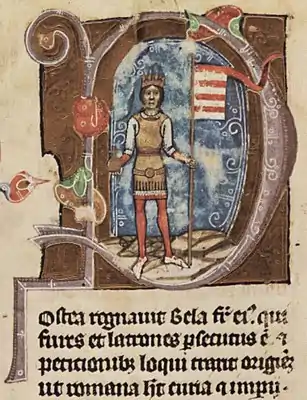 King Béla III |
King Béla III
|
| Page 122 | 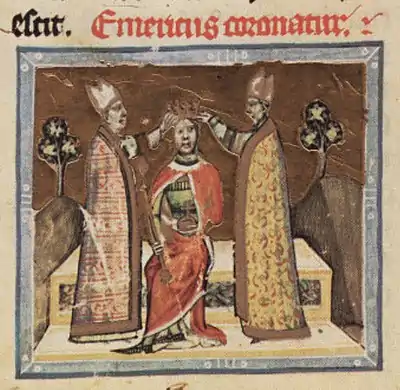 Coronation of King Emeric |
Coronation of King Emeric |
| Page 123 | 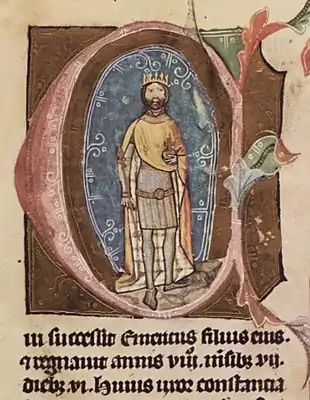 King Emeric |
King Emeric
|
| Page 123 | 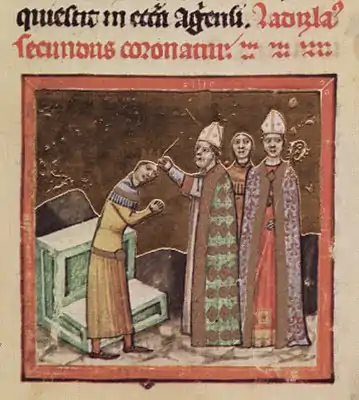 Coronation of King Ladislaus III |
Coronation of King Ladislaus III
|
| Page 123 |  King Ladislaus III |
King Ladislaus III
|
| Page 123 | 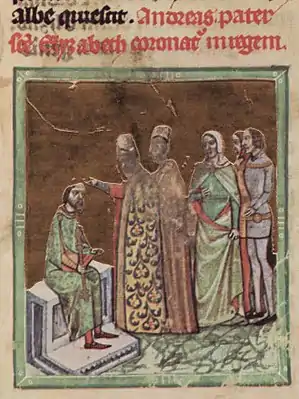 Coronation of King Andrew II |
Coronation of King Andrew II
|
| Page 124 |  King Andrew II |
King Andrew II
|
| Page 124 | 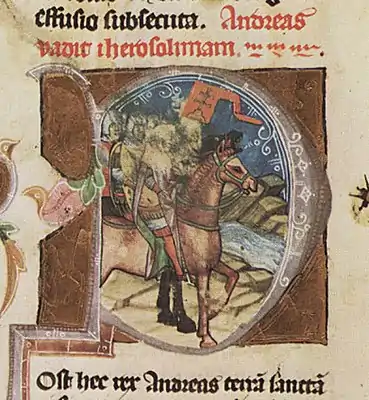 King Andrew II at the Head of His Crusader Army |
King Andrew II at the Head of His Crusader Army
|
| Page 125 | 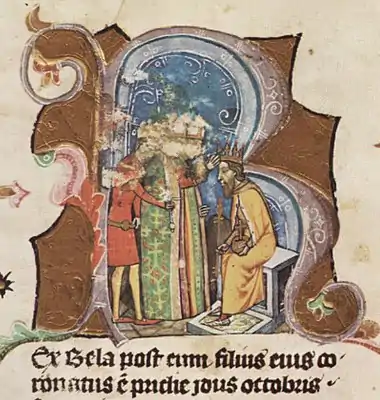 Coronation of King Béla IV |
Coronation of King Béla IV |
| Page 125 | 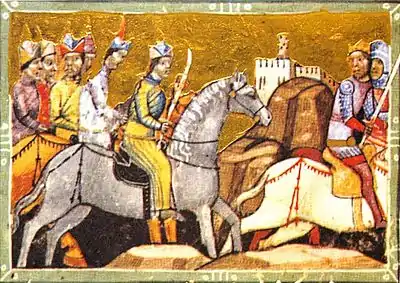 The First Arrival of the Mongols |
The First Arrival of the Mongols |
| Page 126 |  The Fight of King Béla IV of Hungary with King Ottokar II of Bohemia |
The Fight of King Béla IV of Hungary with King Ottokar II of Bohemia
|
| Page 126 | King Béla IV |
King Béla IV
|
| Page 126 | 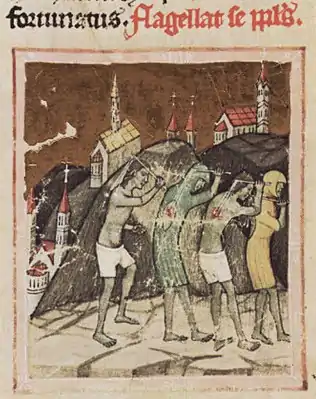 Flagellants |
Flagellants
|
| Page 127 | 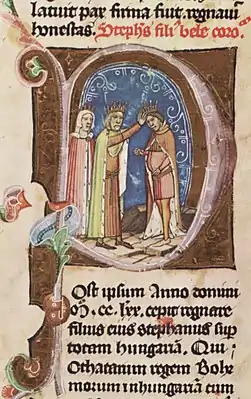 Coronation of King Stephen V |
Coronation of King Stephen V
|
| Page 128 | King Ladislaus IV |
King Ladislaus IV
|
| Page 128 |  The Second Mongol Invasion |
The Second Mongol Invasion
|
| Page 129 |  Bishop Philip of Fermo, the Papal Legate Is Coming to Hungary |
Bishop Philip of Fermo, the Papal Legate Is Coming to Hungary
|
| Page 129 | The Murdered King Ladislaus the Cuman and His Murderers |
The Murdered King Ladislaus the Cuman and His Murderers
|
| Page 130 | 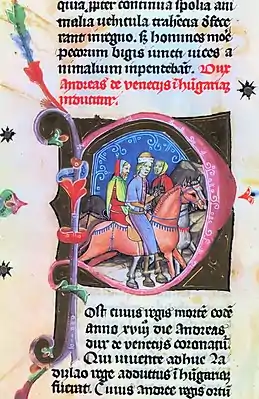 Prince Andrew Is Brought to Hungary |
Prince Andrew Is Brought to Hungary
|
| Page 131 | 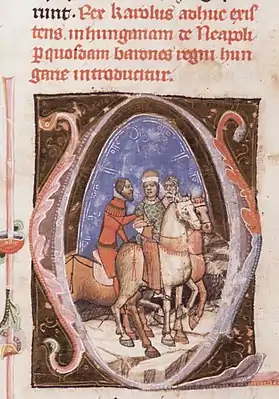 The Child Charles Robert Is Brought to Hungary |
The Child Charles Robert Is Brought to Hungary
|
| Page 132 | 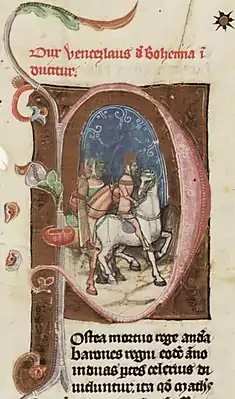 Prince Wenceslaus Arrives in Hungary |
Prince Wenceslaus Arrives in Hungary
|
| Page 133 | 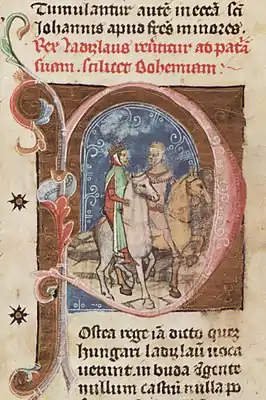 King Wenceslaus returns to Bohemia |
King Wenceslaus returns to Bohemia
|
| Page 134 | 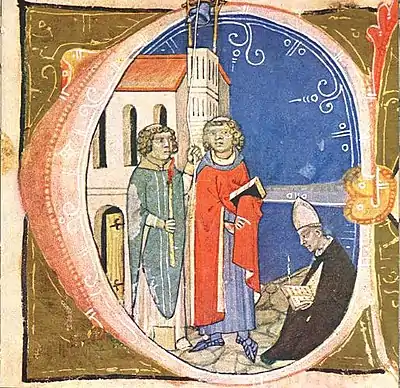 The Priests of Buda Curse the Pope |
The Priests of Buda Curse the Pope
|
| Page 135 | Recovery of the Lost Crown |
Recovery of the Lost Crown
|
| Page 136 | 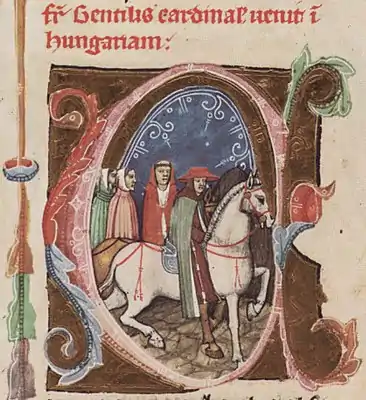 Cardinal Gentile Arrives in Hungary |
Cardinal Gentile Arrives in Hungary
|
| Page 137 |  Battle of Rozgony |
Battle of Rozgony
|
| Page 138 | 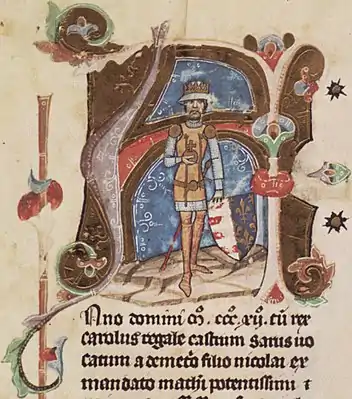 King Charles Robert |
King Charles Robert
|
| Page 139 |  The First Wife of King Charles Robert, Mary Is Placed in a Coffin |
The First Wife of King Charles Robert, Mary Is Placed in a Coffin
|
| Page 139 | 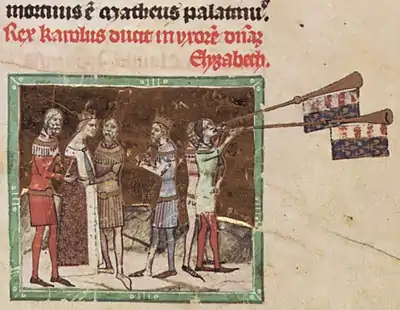 The Wedding of King Charles Robert With Elizabeth, the Daughter of the Polish King Władysław |
The Wedding of King Charles Robert With Elizabeth, the Daughter of the Polish King Władysław
|
| Page 140 |  Queen Elizabeth With Her Children |
Queen Elizabeth With Her Children
|
| Page 140 | 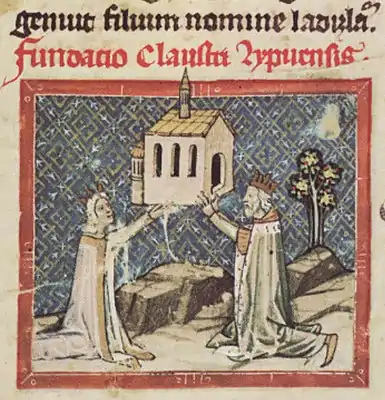 The Founding of the Monastery in Lippa |
The Founding of the Monastery in Lippa
|
| Page 140 | 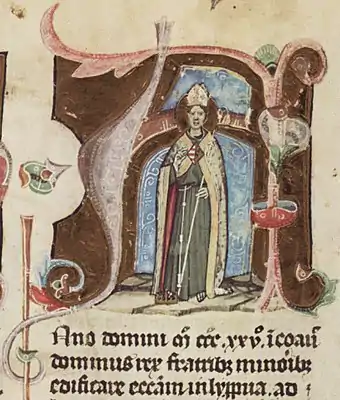 Saint Louis of Toulouse |
Saint Louis of Toulouse
|
| Page 140 | 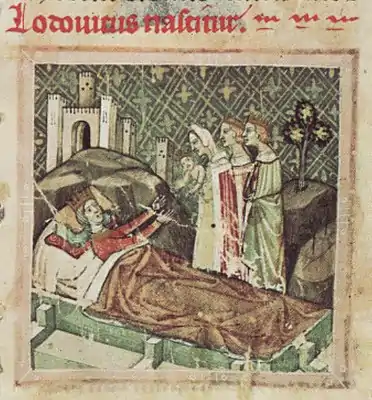 Birth of King Louis |
Birth of King Louis
|
| Page 141 | 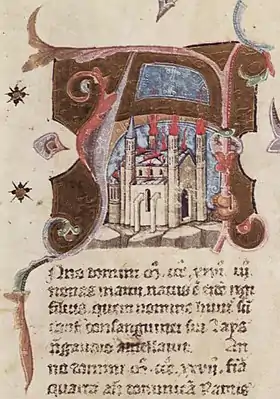 Birth of King Louis |
The Burning of the Church in Székesfehérvár
|
| Page 141 | 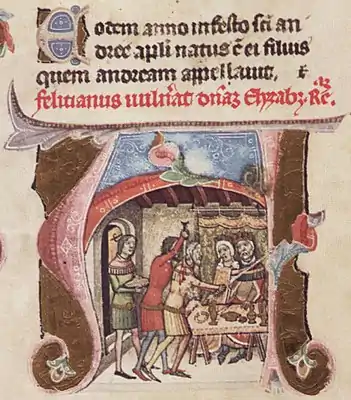 Felician Záh’s Assassination Against the Royal Family |
Felician Záh’s Assassination Against the Royal Family
|
| Page 143 | The Defeat of King Charles in the Campaign Against Basarab |
The Defeat of King Charles in the Campaign Against Basarab
|
| Page 144 | 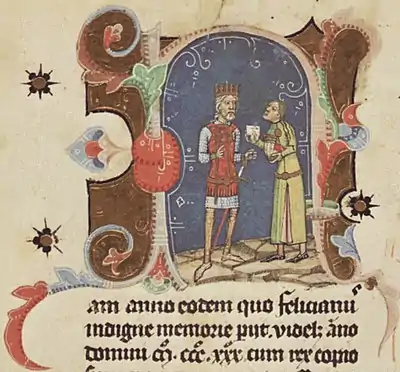 King Charles Receives the Envoy of Voivode Basarab |
King Charles Receives the Envoy of Voivode Basarab
|
| Page 146 | 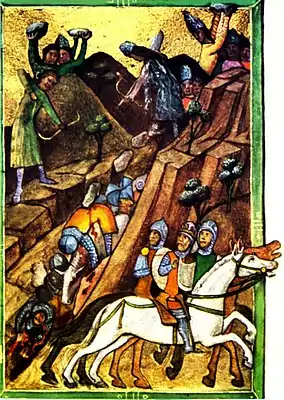 Victory of Basarab Over the Royal Army |
Victory of Basarab Over the Royal Army
|
See also
References
- Hóman, Bálint (1925). "A magyarok hún-hagyománya – Kézai Simon hún-krónikája" [The Hun Tradition of the Hungarians - The Hun Chronicle of Simon Kézai]. A magyar hún-hagyomány és hún-monda [The Hungarian Hun Tradition and Hun Legend] (in Hungarian). Budapest: Hungarian Academy of Sciences.
- Dr. Szabados, György (1998). "A krónikáktól a Gestáig – Az előidő-szemlélet hangsúlyváltásai a 15–18. században" [From the chronicles to the Gesta - Shifts in emphasis of the pre-time perspective in the 15th–18th centuries]. Irodalomtörténeti Közlemények, 102 (5-6) (PDF) (in Hungarian). MTA Irodalomtudományi Intézet (Institute for Literary Studies of Hungarian Academy of Sciences). pp. 615–641. ISSN 0021-1486.
- Pražák, Nechutová, Bartoňková (1988). Legendy a kroniky koruny Uherské (Legends and chronicles of Hungarian crown). Prague: Nakladatelství Vyšehrad. pp. 340–346.
{{cite book}}: CS1 maint: multiple names: authors list (link) - Dercsinyi, Dezső (1964). A Képes krónika és kora (The Chronicon Pictum and Its Age) (in Hungarian). Budapest.
{{cite book}}: CS1 maint: location missing publisher (link) - CEU Press (2018). "The Illuminated Chronicle: Chronicle of the Deeds of the Hungarians from the Fourteenth-Century Illuminated Codex". CEU Press – Central European University.
- Mark of Kalt: Chronicon Pictum https://mek.oszk.hu/10600/10642/10642.htm
External links
- Kalt, Marci (1358). Chronicon Pictum (PDF) (in Latin). Archived from the original (PDF) on 2012-03-04.
- M. Florianus, ed. (1883). Chronica Hungarorum: Chronicon Pictum Vindobonense (in Latin). Lipsiae (Leipzig). pp. 100–302.
{{cite book}}: CS1 maint: location missing publisher (link) - Podhradczky, József (1838) [1365]. Chronicon Budense (in Latin). Buda. – A more readable Latin text, with notes in Latin
- Geréb, László; Dercsinyi, Dezső; Csapodiné Gárdonyi, Klára; Mezey, Lázsló (1964). Képes Krónika [Illuminated Chronicle] (PDF) (in Hungarian). Budapest: Magyar Helikon.
- Geréb, László (1993). Képes Krónika [Illuminated Chronicle] (in Hungarian). Magyar Hírlap and Maecenas Kiadó. ISBN 963-8164-07-7.